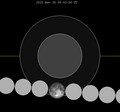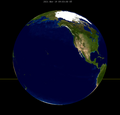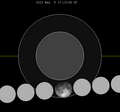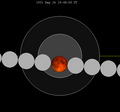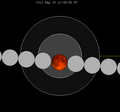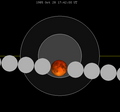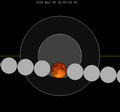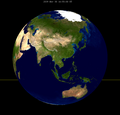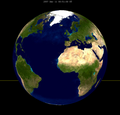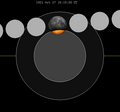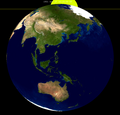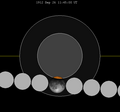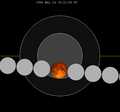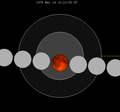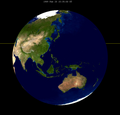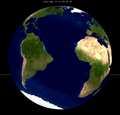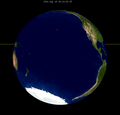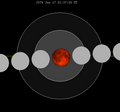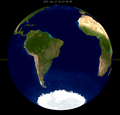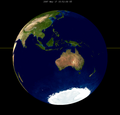Top Qs
Timeline
Chat
Perspective
November 2021 lunar eclipse
Partial lunar eclipse of 19 November 2021 From Wikipedia, the free encyclopedia
Remove ads
A partial lunar eclipse occurred at the Moon’s ascending node of orbit on Friday, November 19, 2021,[2] with an umbral magnitude of 0.9760. A lunar eclipse occurs when the Moon moves into the Earth's shadow, causing the Moon to be darkened. A partial lunar eclipse occurs when one part of the Moon is in the Earth's umbra, while the other part is in the Earth's penumbra. Unlike a solar eclipse, which can only be viewed from a relatively small area of the world, a lunar eclipse may be viewed from anywhere on the night side of Earth. Occurring only about 12 hours before apogee (on November 20, 2021, at 21:10 UTC), the Moon's apparent diameter was smaller.[3]
This was the longest partial lunar eclipse since February 18, 1440, and the longest until February 8, 2669; however, many eclipses, including the November 2022 lunar eclipse, have a longer period of umbral contact at next to 3 hours 40 minutes.[4][5] It was often referred to as a "Beaver Blood Moon" although not technically fulfilling the criteria for a true blood moon (totality).
This lunar eclipse was the second of an almost tetrad, with the others being on May 26, 2021 (total); May 16, 2022 (total); and November 8, 2022 (total).
Remove ads
Visibility
The eclipse was completely visible over northeast Asia, the Pacific Ocean, and North America, seen rising over east Asia and Australia and setting over South America.[6]
  |
 Visibility map |
Gallery
- Madrid, Spain, 7:29 UTC
- Nara City, Japan, 8:51 UTC
- Toronto, Ontario, 8:53 UTC
- Warrenton, Virginia, 9:01 UTC
- New Plymouth, New Zealand, 9:03 UTC
- Santa Fe, New Mexico, 9:03 UTC
- Jayapura, Indonesia, 9:04 UTC
- Mexico City, Mexico, 9:08 UTC
- Killingly, Connecticut, 9:12 UTC
- Dayton, Ohio, 9:25 UTC
- Hefei, China, 10:35 UTC
- Eclipse progression as seen from Texas
- Weifang, China, taken began at 10:31 UTC
Eclipse details
Shown below is a table displaying details about this particular lunar eclipse. It describes various parameters pertaining to this eclipse.[7]
Eclipse season
This eclipse is part of an eclipse season, a period, roughly every six months, when eclipses occur. Only two (or occasionally three) eclipse seasons occur each year, and each season lasts about 35 days and repeats just short of six months (173 days) later; thus two full eclipse seasons always occur each year. Either two or three eclipses happen each eclipse season. In the sequence below, each eclipse is separated by a fortnight.
Remove ads
Related eclipses
Summarize
Perspective
Eclipses in 2021
- A total lunar eclipse on May 26.
- An annular solar eclipse on June 10.
- A partial lunar eclipse on November 19.
- A total solar eclipse on December 4.
Metonic
- Preceded by: Lunar eclipse of January 31, 2018
- Followed by: Lunar eclipse of September 7, 2025
Tzolkinex
- Preceded by: Lunar eclipse of October 8, 2014
- Followed by: Lunar eclipse of December 31, 2028
Half-Saros
- Preceded by: Solar eclipse of November 13, 2012
- Followed by: Solar eclipse of November 25, 2030
Tritos
- Preceded by: Lunar eclipse of December 21, 2010
- Followed by: Lunar eclipse of October 18, 2032
Lunar Saros 126
- Preceded by: Lunar eclipse of November 9, 2003
- Followed by: Lunar eclipse of November 30, 2039
Inex
- Preceded by: Lunar eclipse of December 9, 1992
- Followed by: Lunar eclipse of October 30, 2050
Triad
- Preceded by: Lunar eclipse of January 19, 1935
- Followed by: Lunar eclipse of September 20, 2108
Lunar eclipses of 2020–2023
This eclipse is a member of a semester series. An eclipse in a semester series of lunar eclipses repeats approximately every 177 days and 4 hours (a semester) at alternating nodes of the Moon's orbit.[8]
The penumbral lunar eclipses on January 10, 2020 and July 5, 2020 occur in the previous lunar year eclipse set.
Metonic series
- First eclipse: November 20, 2002.
- Second eclipse: November 19, 2021.
- Third eclipse: November 18, 2040.
- Fourth eclipse: November 19, 2059.
- Fifth eclipse: November 19, 2078.
Saros 126
This eclipse is a part of Saros series 126, repeating every 18 years, 11 days, and containing 70 events. The series started with a penumbral lunar eclipse on July 18, 1228. It contains partial eclipses from March 24, 1625 through June 9, 1751; total eclipses from June 19, 1769 through November 9, 2003; and a second set of partial eclipses from November 19, 2021 through June 5, 2346. The series ends at member 70 as a penumbral eclipse on August 19, 2472.
The longest duration of totality was produced by member 36 at 106 minutes, 27 seconds on August 13, 1859. All eclipses in this series occur at the Moon’s ascending node of orbit.[9]
Eclipses are tabulated in three columns; every third eclipse in the same column is one exeligmos apart, so they all cast shadows over approximately the same parts of the Earth.
Tritos series
This eclipse is a part of a tritos cycle, repeating at alternating nodes every 135 synodic months (≈ 3986.63 days, or 11 years minus 1 month). Their appearance and longitude are irregular due to a lack of synchronization with the anomalistic month (period of perigee), but groupings of 3 tritos cycles (≈ 33 years minus 3 months) come close (≈ 434.044 anomalistic months), so eclipses are similar in these groupings.
Inex series
This eclipse is a part of the long period inex cycle, repeating at alternating nodes, every 358 synodic months (≈ 10,571.95 days, or 29 years minus 20 days). Their appearance and longitude are irregular due to a lack of synchronization with the anomalistic month (period of perigee). However, groupings of 3 inex cycles (≈ 87 years minus 2 months) comes close (≈ 1,151.02 anomalistic months), so eclipses are similar in these groupings.
Half-Saros cycle
A lunar eclipse will be preceded and followed by solar eclipses by 9 years and 5.5 days (a half saros).[11] This lunar eclipse is related to two total solar eclipses of Solar Saros 133.
| November 13, 2012 | November 25, 2030 |
|---|---|
 |
 |
Remove ads
See also
References
External links
Wikiwand - on
Seamless Wikipedia browsing. On steroids.
Remove ads





















